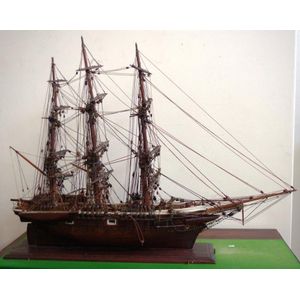Antique 'Edinburgh' Model in Mahogany Display Case
Antique model 'Edinburgh' in mahogany display case circa 1840 - 1860. Model attributed to have been presented by Shackleton and Mawson to Captain Davis who rescued them off the ice floe in the Antarctic. Donated to maritime model Museum by a family friend of Captain Davis to whom Davis had bequeathed it as referenced in an article of an interview with the Museum Director in Pittwater Online news, issue 91, November 30 - 6 December 2014. Model dimensions 100 cm length, 75 cm height, 15 cm beam approx. Display case dimensions 115 cm length, 83 cm height, 45 cm width.
You must be a subscriber, and be logged in to view price and dealer details.
Subscribe Now to view actual auction price for this item
When you subscribe, you have the option of setting the currency in which to display prices to $Au, $US, $NZ or Stg.
This item has been sold, and the description, image and price are for reference purposes only.
- Circa - A Latin term meaning 'about', often used in the antique trade to give an approximate date for the piece, usually considered to be five years on either side of the circa year. Thus, circa 1900 means the piece was made about 1900, probably between 1895 and 1905. The expression is sometimes abbreviated to c.1900.
- Attributed - A cataloguing term where the item in the opinion of the cataloguers, is a of the period of the artist, craftsman or designer, and which probably in whole or part is the work of that person.
- Mahogany - Mahogany is a dense, close grained red-coloured timber from the West Indies and Central America. It was first imported into Europe in the the early 18th century and its use continued through the 19th century. It was popular for furniture making because of its strength, the wide boards available, the distinctive grain on some boards, termed flame mahogany and the rich warm colour of the timber when it was polished.. The "flame" was produced where a limb grew out from the trunk of the tree, and this timber was usually sliced into veneers for feature panels on doors, backs and cornices.
Some terms used to describe mahogany relate to the country from which it originally came, such as "Cuban" mahogany, "Honduras" mahogany etc. However unless the wood has been tested the names assigned are more a selling feature, rather than a true indication of the timber's origin.
This item has been included into following indexes:
